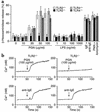Differential responses of mast cell Toll-like receptors 2 and 4 in allergy and innate immunity
- PMID: 12021251
- PMCID: PMC150977
- DOI: 10.1172/JCI14704
Differential responses of mast cell Toll-like receptors 2 and 4 in allergy and innate immunity
Abstract
Toll-like receptor 2 (TLR2) and TLR4 play important roles in the early innate immune response to microbial challenge. To clarify the functional roles of TLRs 2 and 4 in mast cells, we examined bone marrow-derived mast cells (BMMCs) from TLR2 or TLR4 gene-targeted mice. Peptidoglycan (PGN) from Staphylococcus aureus stimulated mast cells in a TLR2-dependent manner to produce TNF-alpha, IL-4, IL-5, IL-6, and IL-13, but not IL-1beta. In contrast, LPS from Escherichia coli stimulated mast cells in a TLR4-dependent manner to produce TNF-alpha, IL-1beta, IL-6, and IL-13, but not IL-4 nor IL-5. Furthermore, TLR2- but not TLR4-dependent mast cell stimulation resulted in mast cell degranulation and Ca2+ mobilization. In a mast cell-dependent model of acute sepsis, TLR4 deficiency of BMMCs in mice resulted in significantly higher mortality because of defective neutrophil recruitment and production of proinflammatory cytokines in the peritoneal cavity. Intradermal injection of PGN led to increased vasodilatation and inflammation through TLR2-dependent activation of mast cells in the skin. Taken together, these results suggest that direct activation of mast cells via TLR2 or TLR4 by respective microligands contributes to innate and allergic immune responses.
Figures





References
-
- Metcalfe DD, Baram D, Mekori YA. Mast cells. Physiol Rev. 1997;77:1033–1079. - PubMed
-
- Weber S, et al. Mast cells. Int J Dermatol. 1995;34:1–10. - PubMed
-
- Bradding P, Holgate ST. Immunopathology and human mast cell cytokines. Crit Rev Oncol Hematol. 1999;31:119–133. - PubMed
-
- Galli SJ, Wershil BK. The two faces of the mast cells. Nature. 1996;381:21–22. - PubMed
-
- Malaviya R, Ikeda T, Ross E, Abraham SN. Mast cell modulation of neutrophil influx and bacterial clearance at sites of infection through TNF-alpha. Nature. 1996;381:77–80. - PubMed
Publication types
MeSH terms
Substances
LinkOut - more resources
Full Text Sources
Other Literature Sources
Medical
Molecular Biology Databases
Miscellaneous

